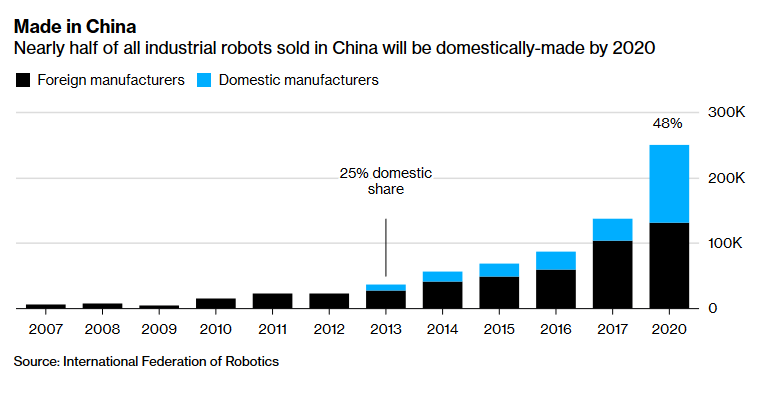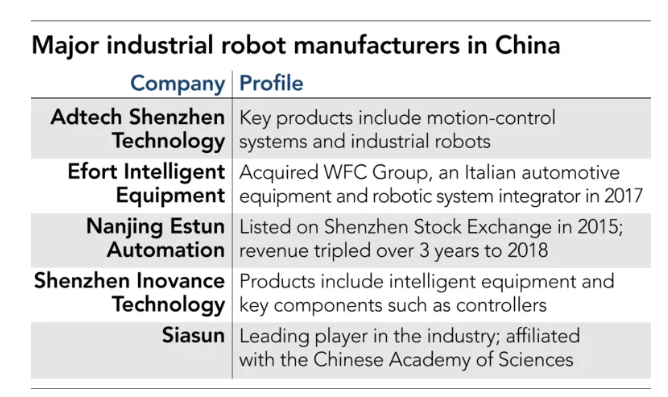
Can Homegrown Robots Compete?
China’s Journey to Self-Reliance in Robots
Long maligned as inferior to their foreign competitors, some Chinese robots have markedly improved
— is not being pushed just by the Communist Party’s top leaders. Instead, the drive is also coming from the bottom up:
from the businesses and cities across China that know they must modernize or perish.” —Li Yuan, New York Times
It’s that simple: Modernize or perish
For a country faced with “modernize of perish,” China is lucky that the Great Sino-American Trade War happened now and not five years ago.
Back in 2014-2015, robotics in China was still settling in with a growing list of new homegrown robot builders, while in-country foreign firms were just amping up their presence and capacity. The timely acquisitions of robot giant KUKA, as well as a raft of other German high-tech automation companies, were pulled off in relative calm. Times have changed. Hyper-scrutiny of everything rules the day.
The uncomfortable truth is that in the process of chasing industrial automation so desperately China made itself overly vulnerable to the very thing that it sought. Maybe it lingered too long drinking from the well of easy automation. Lots of cash in exchange for lots of high-tech gear can’t last forever; some political upheaval or financial cycle was eventually going to arise and screw up the works.
And finally, it did. If it wasn’t Trump’s trade war, it would have been someone or something else, like Japan’s current squabble with Korea, only on a mega scale. Like Japan suddenly shutting down robot parts shipments to China.
China’s investment in smart manufacturing—robots and parts, plus automation and other technologies in order to hike productivity and cut labor costs—surged 46 percent in 2018 to $10.1 billion, reported Marketing Intelligence Resource (MIR), a Beijing-based research firm specializing in industrial products.
“The number of subsidized investments remained unchanged at 100, while unsubsidized ones doubled to more than 1,000, according to MIR.”
China’s getting squeezed. But, under the gun of “modernize or perish,” it’ll have to continue to pay whatever the cost, unless there’s an alternative. China’s own domestic robot-building capacity is still new, but said to be ready. And there’s nothing like a national crisis to test just how ready it is.
Journey to self-reliance
With varying degrees of dependency, China has other high-tech vulnerabilities in semiconductors, artificial intelligence, and self-driving vehicles; all of which need a jump up in homegrown self-reliance if the future is to be kinder to China than the present.
Although Alibaba has just released a RISK-V-based chip, it’s not enough. “There are alternatives in China, but the gap in technology is too big,” said an executive from one of China’s leading artificial intelligence chipmakers, which relies on U.S. technology for chip design. “If we lose access to U.S. software or can no longer receive updates, our chip development will run into a dead end,” he told the Nikkei Asian Review, speaking on condition of anonymity.
Then again, China pays out a fortune in licenses and royalties to the U.S., Germany, and Japan; a total of $29 billion in 2017! Would be nice to save a bit of that for the home front.
Could home-grown robots compete?
With robotics, China has a shot at self-sufficiency relatively soon; soon meaning a skinny decade or less. China is aiming for 70 percent of its robots to be domestically produced by 2025 (30 percent in 2017)

“It will be a difficult technological challenge,” said Hiroyuki Hayashi, a director at MIR. He believes that the domestic share will be more like 40 percent by 2025.
With foreign robot makers like FANUC, ABB, and Yaskawa controlling over 60 percent of the industrial robot market in China, domestic producers have their work cut out for them.

Hayashi notes that domestic robot builders will see their sales increase as domestic demand grows, “but they will face an uphill battle against foreign rivals, especially in the market for high-end products used to make cars and electronics.”
Long maligned as inferior to their foreign competitors, some Chinese robots have improved markedly. Siasun’s robots, for example, have won rare praise from Japan: Kazuhiro Kosuge, a robotics professor at Tohoku University’s graduate school, says they are “on a par with those of Japanese and European manufacturers.”
Why not use what you already own?
Then too, China now owns the world’s legit #3 or #4 robot builder in KUKA, including its IP (intellectual property); plus, it also acquired Servotronix, makers of motion controllers, machine interfaces, servo motors and servo drives. Combine all those goods together with those from China’s up-and-coming sensor tech and its artificial intelligence ecosystem, and the makings of a world-class industrial robot begin to appear.
At the time of the KUKA acquisition, KUKA’s Wilfried Eberhardt told Caixin in an interview: “KUKA will help Midea grab more share in the future robot market.” Now might be a good time to call in that promise.
China may be able to pick up ground in expanded sales if it could offer customers a “smart” industrial robot rather than just an industrial robot. Smart as in imbued with some of China’s vaunted AI expertise.
By 2020, according to IDC’s Jing Bing Zhang, “45 percent of newly installed industrial robots will have at least one intelligent feature, such as predictive analytics, health condition awareness, self-diagnosis, peer-learning, or autonomous cognition.”
“These are not so much new technologies,” adds IDC’s John Santagate, “as they are additional technologies — machine learning, intelligence, industrial internet of things connectivity, and predictive maintenance because of that connectivity — being layered onto existing robotics technologies,” …and that by 2021, “intelligent robotics agents will supervise and coordinate industrial robots, boosting their overall efficiency by 30 percent.”
That “overall efficiency by 30 percent” could well be the holy grail of “Made in China 2025”, as China’s artificial intelligence tech comes to bear on industrial robots and the factories where they work.
A fen saved is a fen earned
In addition to a huge leap forward in national pride, competitive domestic robots—many half the price of foreign rivals—could well save billions of dollars. Billions that will be necessary to meet the growing demands of China’s burgeoning middle class (some 500 million, and growing fast).
More money for basics like clean water, clean air, quality food, safe pharmaceuticals, affordable home appliances, better health care, better education, a stronger social net, some of the essentials that every middle class needs to flourish, but are expensive for a government to provide.
In the process, China may also develop an important and valuable industrial robot for export. Siasun is on its way to that goal already; it’s building out 470 acres of Thailand’s Eastern Economic Corridor: Siasun Seeks to Develop Huge Tract of Thailand.
Self-reliance in robotics and a big win-win opportunity…resulting from a trade war.
See related: Why China Can’t Stop Spending Multi-Billions of Dollars on Robots, Cobots, Grippers, Robot Parts, and AVGs

